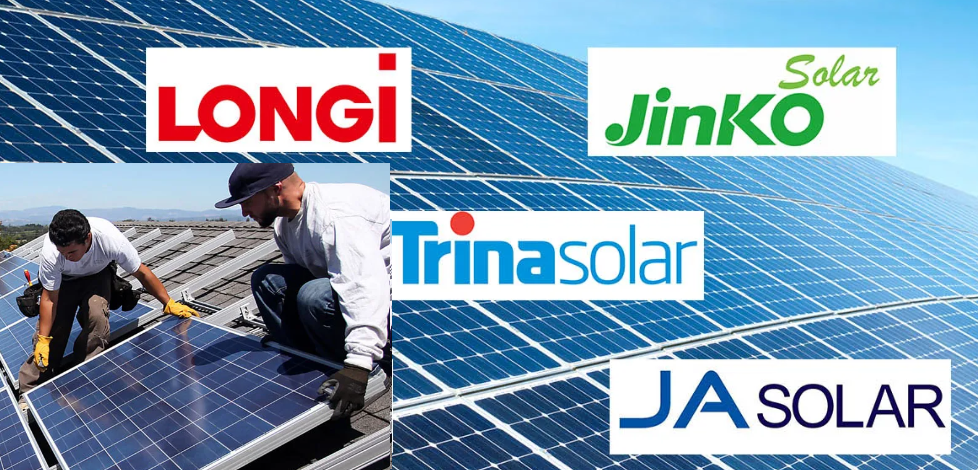Discover efficient and reliable solar panels for your home. Find out which brands lead the market in terms of performance and value.

1. Introduction to Residential Solar Panels
Solar panels have become popular for homeowners looking to reduce their energy bills and environmental impact. As technology advances, these panels are becoming more efficient and affordable. But with so many options available, how do you choose the right one for your home?
1.1. Benefits of solar energy for homeowners
Hey there! If you’re thinking about going solar, you’re in for some great benefits. Solar energy can help you save money on your electricity bills, increase your home’s value, and reduce your carbon footprint. It’s like having a mini power plant right on your roof!
1.2. How solar panels work
Solar panels are pretty cool gadgets. They capture sunlight and turn it into electricity for your home. It’s like magic, but it’s actually science! The panels have special cells that get excited when sunlight hits them, creating an electric current that powers your home.
1.3. Key factors to consider when choosing solar panels
When selecting solar panels, consider efficiency, durability, cost, warranty, and aesthetics. Your location, roof type, and energy needs also play crucial roles in this decision.
Solar Panel Best Brand Available in the Market
| Feature | Longi 500W | Jinko 500W | JA Solar 500W | Trina 500W |
| Link | Check on AliExpress | Check on AliExpress | Check on AliExpress | Check on AliExpress |
| Efficiency | Up to 21.3% | 20.55% | 21.0% | Up to 20.7% |
| Power Output | 500W | 500W | 500W | 500W |
| Cell Type | Mono PERC | Mono PERC | Mono PERC | Mono PERC |
| Warranty | 25-year performance warranty | 25-year product warranty, 30-year performance warranty | 12-year product warranty, 25-year performance warranty | 25-year performance warranty |
| Temperature Coefficient | -0.35%/°C | -0.35%/°C | -0.35%/°C | -0.34%/°C |
| Size | 2094 x 1134 x 35 mm | 2274 x 1134 x 35 mm | 2172 x 1030 x 35 mm | 2187 x 1102 x 35 mm |
| Weight | 26 kg | 28.9 kg | 25.0 kg | 26.5 kg |
| Bifacial Factor | Up to 30% | Up to 30% | Up to 30% | Up to 30% |
| Degradation Rate | 0.55% annual | 0.55% annual | 0.55% annual | 0.55% annual |
Solar Panels Brand Pros and Cons
| Pros | Cons |
| Longi 500W Data Sheet | |
| – Higher efficiency | – Slightly heavier |
| – Larger size for more power per panel | – May be more expensive |
| – Strong brand reputation | – Potentially longer lead times |
| Trina 500W Data Sheet | |
| – Slightly better temperature coefficient | – Lower efficiency |
| – Lighter weight | – Smaller size |
| – Potentially more cost-effective | – Less brand recognition in some markets |
| Jinko 500W Data Sheet | |
| – Higher efficiency | – Slightly heavier |
| – Longer warranty | – Potentially higher cost |
| – Established brand reputation | – Larger dimensions |
| JA Solar 500W Data Sheet | |
| – Lighter weight | – Lower efficiency |
| – Compact dimensions | – Shorter warranty |
| – Potentially lower cost | – Less established brand reputation |
Who could choose;
Longi 500W:
- Homeowners with limited roof space looking for maximum power output
- Commercial installations prioritizing efficiency and brand reputation
- Projects in areas with high electricity costs, benefiting from higher efficiency
Trina 500W:
- Budget-conscious consumers seeking a balance of performance and cost
- Installations where weight is a concern, such as older roofs or lightweight structures
- Projects in hotter climates, benefiting from the slightly better temperature coefficient
Jinko 500W:
- Consumers prioritizing long-term reliability and performance
- Those with ample roof space for installation
- Buyers willing to invest in premium solar technology
JA Solar 500W:
- Budget-conscious consumers
- Those with limited roof space or weight restrictions
- Buyers focusing on immediate cost savings rather than long-term warranties
2. Top Solar Panel Brands for Residential Applications
2.1. Longi: High efficiency and premium quality
Longi is like the luxury car of solar panels. They’re known for their high efficiency, which means they can produce more power in less space. If you have a smaller roof or just want top-notch performance, Longi might be your go-to.
2.2. Jinko: Reliable performance and sleek design
Jinko panels are the dependable friend of the solar world. They offer solid performance and look pretty nice on your roof too. If you want a good balance of looks and functionality, Jinko could be a great choice.
2.3. JA Solar: Advanced technology and durability
JA Solar is all about innovation. They’re always coming up with new ways to make their panels more efficient and long-lasting. If you’re a tech enthusiast who wants the latest and greatest, JA Solar might be right up your alley.
2.4. Trina: Cost-effective and versatile options
Trina is like the budget-friendly option that doesn’t skimp on quality. They offer a range of panels to suit different needs and budgets. If you’re looking to save some money without sacrificing performance, Trina could be the way to go.
3. Evaluating Solar Panel Efficiency and Performance
3.1. Understanding Solar Panel Efficiency Ratings
If you’re interested in the latest advancements in solar panel technology, JA Solar offers highly efficient and long-lasting panels. On the other hand, if you’re looking for a cost-effective option without compromising quality, Trina provides versatile panels that suit different budgets. Understanding solar panel efficiency ratings is crucial as they indicate how effectively sunlight is converted into electricity, with higher efficiency resulting in more power generation. It’s similar to achieving more miles per gallon in a car.
3.2. Factors affecting solar panel performance
A lot of things can impact how well your panels work. Things like shade, temperature, and the angle of your roof. It is important to consider these factors when planning your solar setup. Shade can significantly reduce the amount of sunlight reaching your panels, impacting their efficiency. Temperature also plays a role, as high temperatures can cause a decrease in panel performance. Additionally, the angle of your roof affects the amount of sunlight your panels receive throughout the day. By taking these factors into account, you can optimize the performance of your solar panels and maximize your energy generation.
3.3. Comparing power output and energy production
When evaluating solar panels for your home, it is crucial to compare their power output and energy production. These factors determine the amount of electricity the panels can generate. Just like comparing the lifting capacity of different exercise machines, understanding the power output and energy production of solar panels helps you make an informed decision for your solar setup.

4. Durability and Longevity of Solar Panels
4.1. Weather resistance and build quality
Solar panels need to be tough cookies to withstand all kinds of weather. Good panels are built to handle rain, wind, snow, and even hail. It’s like choosing outdoor furniture that can stand up to the elements.
4.2. Warranty coverage and manufacturer support
A good warranty is like a safety net for your investment. Look for panels with solid warranty coverage and responsive manufacturer support. It’s reassuring to know you’re covered if something goes wrong.
4.3. Expected lifespan and degradation rates
Most solar panels are built to last 25-30 years or more. But over time, they slowly produce less energy. This is called degradation. Look for panels with low degradation rates to get the most out of your investment over time.

5. Cost Considerations and Return on Investment
5.1. Initial installation costs and long-term savings
Going solar does have an upfront cost, but think of it as an investment. You’re paying now to save money on electricity bills for years to come. It’s like planting a money tree that grows over time!
5.2. Available incentives and tax credits
There are often government incentives and tax credits available for going solar. These can really help offset the initial cost. It’s like getting a discount on your solar system!
5.3. Calculating payback period and ROI
To figure out if solar is worth it for you, you’ll want to calculate the payback period and return on investment (ROI). This tells you how long it’ll take for your savings to cover the cost of the system. It’s like figuring out how long it’ll take for a savings account to double your money.
6. Installation and Maintenance Requirements
6.1. Roof suitability and mounting options
Not all roofs are created equal when it comes to solar. You’ll need to consider things like the angle, direction, and strength of your roof. There are different mounting options to suit different roof types.
6.2. Professional installation vs. DIY approaches
While some handy folks might be tempted to install solar panels themselves, it’s usually best to leave it to the pros. They have the experience and tools to do it safely and correctly. It’s like the difference between cutting your own hair and going to a salon.
6.3. Ongoing maintenance and cleaning needs
Solar panels are pretty low maintenance, but they do need some TLC now and then. Regular cleaning and occasional check-ups can help keep them working their best. It’s like getting regular oil changes for your car.
7. Comparing the Top 4 Solar Panels
7.1. Side-by-side performance analysis
When comparing efficiency, Jinko and JA Solar panels tend to edge out the competition slightly. However, Trina and Longi aren’t far behind and may perform better in specific conditions.
7.2. Price vs. value comparison
While Jinko and JA Solar panels may have higher upfront costs, their efficiency could lead to greater long-term savings. Trina and Longi offer excellent value for those with tighter budgets.
7.3. Best scenarios for each panel
Longi: Suitable for those prioritizing easy installation and maintenance
Jinko: Best for homes with limited roof space due to high efficiency
Trina: Ideal for regions with varied weather conditions
JA Solar: Great for tech-savvy homeowners interested in the latest innovations
8. Summary: Making the Right Choice for Your Home
Choosing the right solar panels for your home is a big decision, but it doesn’t have to be overwhelming. Consider your energy needs, budget, and roof characteristics. Don’t be afraid to ask questions and get multiple quotes. With the right setup, you’ll be soaking up the sun and savings in no time!
9. Frequently Asked Questions
9.1. What size solar panel system do I need for my home?
The size of your solar system depends on your energy usage, available roof space, and budget. A solar professional can help you determine the right size for your needs.
9.2. Can I install solar panels if I have a shaded roof?
While shade can reduce solar panel efficiency, there are solutions like micro-inverters or power optimizers that can help. A partially shaded roof doesn’t necessarily rule out solar.
9.3. How long does it take to install a residential solar panel system?
The actual installation usually takes 1-3 days, but the entire process, including permits and inspections, can take several weeks to a few months.
9.4. Are there any disadvantages to using solar panels?
The main drawbacks are the upfront cost and dependence on sunlight. However, for many homeowners, the long-term benefits outweigh these concerns.
Remember, the best solar panel for your specific situation depends on factors like roof space, shading, and climate. Consider consulting with a local solar installer to find the perfect fit for your home





